I saw a religion-themed movie once that actually holds an instructive point for us foragers.
In it a Catholic priest is facing a moral decision that could lead to his death. In his anguish he cries out that it just isn’t fair. He says Christ knew he was the son of God and could go to his death assured things would work out for the best. The priest said everyone else has to guess about what’s going to happen. I feel that way about a particular plant, the Rosary Pea.
I read from credible authorities — folks with PhD’s behind their name — that in at least two places in the world the seeds of this plant are boiled and eaten. When one considers it is also the most toxic seed in the world that gives one a cause to pause. The Rosary Pea (Abrus precatorius) grows abundantly in the southern United States (and other warm areas of the world.) If it were an edible it would be a common one. If fact if it were edible it is so common it could be a staple. But then there’s that toxic side. How toxic? That depends how it gets into your system.
At the moment I weigh 165 pounds or 73,920 grams. One fifteen thousands of your body weight of the seed can kill you by ingestion. 73,920 divided by 15,000 is 4.9, or five grams. About five seeds would be a fatal dose for me if ingested. One seed would make me emergency room sick and require hospitalization. One seed will kill a child. If you inject me with it, however, the poison is incredibly more toxic. Only 3 micrograms are needed, that’s three millionths of a gram. That ain’t much, that’s on the order of less than the tip of a needle. And indeed that is exactly how some accidental deaths have occurred, putting the seed on a thread with a needle and the needle pricking the finger. This is also why one seed sharpened to a point and jabbed into someone causes death and has been used for homicide. There is no antidote only the symptoms can be treated.
If you remember the Bulgarian writer Georgi Markov was killed in a similar fashion. As he stood at a bus stop in London one day in 1978 he felt a sharp jab in the back of his leg. When he turned, a man with an accent apologized for poking him with his umbrella. Three days later, Markov was dead. During the autopsy, doctors removed a metal pellet the size of a pin head from Markov’s leg. The pellet was hollow in the center and contained traces of ricin from the castor bean tree. Abrin is 75 times more toxic than ricin.
In fact Abrin is so toxic that contact between an open or crushed seed and an open wound, like a cut, is also fatal, as is rubbing your eyes after you have touched a broken or powdered seed. However, unbroken a whole mature seed can pass through the system without harm — think boys and pea shooters — though I think I would still get washed out from stem to stern as soon as possible and the seed accounted for. There is no way around the fact the seed is deadly.
Then one reads people boil the seeds for an hour and eat them. That’s not without precedence. We eat pokeweed, which can kill. We boil it two or three times and then enjoy it. Tapioca, before it is processed into tapioca, is deadly. Raw cashews are toxic. Even the common taro cannot be eaten raw. To be specific the toxic protein in the Rosary Pea, Abrin, is reportedly detoxified at 65º C, or 149º F. Boiling, which is quite above that, is probably to make sure the entire seed all the way through is cooked. All of that kind of leaves me in the position of the priest.
The natives who do eat this grow up knowing it is edible. They don’t have to worry about identification or reference secondary sources. I’m 10,000 miles away depending upon the comments of some professionals none of whom say they ate some. That does not exactly instill confidence. Call me old fashion but when a few grams of something can take me out I want to meet someone alive who says they eat it. Better, I want to find someone who does it so I can watch then go back in a few days later to see if they are still alive. I call that the “Dick Deureling” method named after the first forager I studied with in Florida. He would say to a questionable food advocate “let me watch you harvest it, prepare it, cook it and eat it, and if you’re alive a week later I might consider it.”
But I do have an idea… The seed grows everywhere locally. I need to find someone from the two areas of the world where it is reportedly eaten and find out if they eat it here. There is a local grocery that carries food from a part of the world where these seeds are supposedly eaten. I think I’ll get a bottle of Rosary Pea seeds, go there, and see what conversations I can start. Original research. Who knows, maybe they’ve been looking for some…. for cooking, of course….. Stand by.

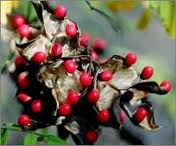
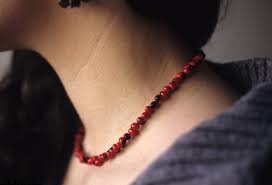
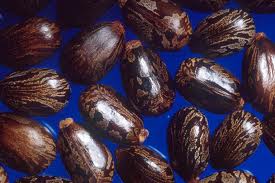
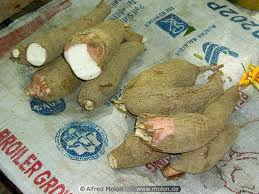
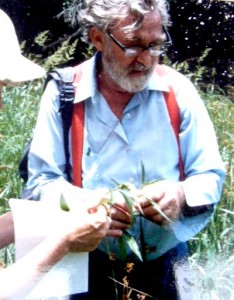

I read in an Indian online ethnobotany magazine that in Orissa state (India), the leaves and seeds are used in traditional medicine. Supposedly, the seeds are consumed with yogurt to induce abortion. However, they could have a less toxic form of the plant (there are different seed-colored varieties in India), and the article was not very specific on how the plant products were prepared. Perhaps you can ask an Oorya (Orissa state person) or someone from another part of India who knows about herbs for more info. Good luck.